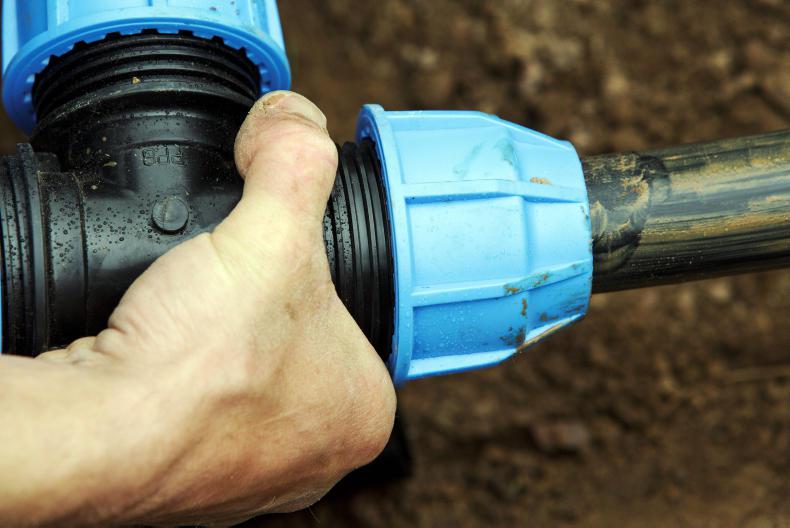Both group schemes and private wells are coming under pressure. Whatever your water source is, there are a number of steps you can take to help ensure an adequate supply for livestock and sprayers.
1.
Check for leaks and be conservative
When you are out checking livestock, always check that the water trough is full and keep an eye out for leaks. Over time, huge volumes of water can be lost via a small leak so they are worth sorting out. Leaks will be apparent where there is unusually damp ground and unexpected lush vegetation, which should be very easy to identify at present. Check meters regularly. If the night usage is unusually high or the counter is still running when everything is turned off, you may have a leak. Water troughs should also be checked for overflowing or poorly adjusted ballcocks.
Any unnecessary washing of sheds should be avoided until water restrictions are eased. On dairy farms, wash the essentials to maintain hygiene in the parlour. Collecting yards should be dry scraped and only areas that are prone to becoming very slippery should be washed. Where irrigation is required for vegetable and arable crops, this work should be carried out at night to reduce evaporation losses.
2.
Take the pressure off your water supply
Having a reservoir in place is a big help in reducing pressure on water sources when demand is strongest. This is particularly apparent in the case of private water wells. Hugh Briody from the well drilling specialist company Tom Briody & Son in Kells, Co Meath, said the company has been inundated with calls regarding issues with water wells. He said the main problem is due to wells being too shallow. “A lot of wells on farms are 30 to 40 years old and are 80ft to 150ft deep. This was adequate for 30 to 40 cows and a dwelling house back then but with herd sizes now a multiple of these figures, these wells can’t cope,” explained Hugh. Discoloured water coming out of your tap is one of the main tell-tale signs that a well is struggling. If you can hear the submersible pump working in the well, it is also a sign that water levels are running low, according to Hugh.
“These shallow wells just can’t keep up. Take a 100-cow dairy herd, for example. They might require up to 5,000l in the hour after the morning milking alone between drinking water and washdown. Some wells might be only able to produce 3,000l/hour,” he said. The best temporary solution where wells are coming under pressure is to set up a storage tank/s with a booster pump to supply paddocks. Hugh says this will take some pressure off the well because a reserve will be in place. This is useful for mains supplies too. In the long-term, farmers should consider boring a new well that is deep enough to have an adequate reserve of water available underground to withstand the pressure from droughts such as this.
A new 6in diameter well over 200ft deep costs over €5,000. Hugh says there is no point trying to deepen an existing well and it is better to have this well available in reserve when required.
3
. Maintain well pumps and components
A combination of increased usage and wells drying up is having an effect on well pumps and their components. Karen Gorey from Glenngorey Pumps said there are a number of steps farmers can take to help the longevity of pumps during the stressful time. Before you carry out any servicing make sure the electrical supply to all parts is switched off first.
Check if the pump is cutting in and out regularly or too quickly. This could be a sign there is a leak in the water supply or a leak in the pressure vessel. The pressure vessel should be sized appropriately for the volume of water required daily.Check the pressure switch. The contacts in the switch can become worn or corroded over time, which prevents them from performing their function of turning the pump off when adequate pressure is built up. If the pump overload in the control box is tripping regularly, it could be a sign that the capacitator is weakening and needs changing. A new capacitator costs approximately €15. It may also be a sign there is a short circuit somewhere. The electric cable supplying the pump should be held securely and not at risk of fraying over time. Submersible pumps should be suspended using a 6mm to 10mm nylon rope. Where the water in a well is at risk of running low in times of peak demand probes can be installed and connected to the control box. They will first give a warning if water supply is running low and if it drops below a very low level, they will cause the pump to switch off. An alternative and cheaper option is a loss of prime pressure switch. This means the pump will not be running constantly and at risk of burning out.Where there is a lot of iron or manganese in a well, pump heads should be cleaned every six months to a year. Some farmers have two pump heads and alternate them so they can carry out this cleaning procedure with a well pump company. Cleaning the head regularly helps avoid damaging the pump. 4.
Use watercourses if all else fails
If all else fails and there is no other option, farmers can organise to remove tank loads of water from rivers and lakes for livestock.
Read more
Rainwater storage – the options
Improving sewage treatment and existing tanks
Both group schemes and private wells are coming under pressure. Whatever your water source is, there are a number of steps you can take to help ensure an adequate supply for livestock and sprayers.
1.
Check for leaks and be conservative
When you are out checking livestock, always check that the water trough is full and keep an eye out for leaks. Over time, huge volumes of water can be lost via a small leak so they are worth sorting out. Leaks will be apparent where there is unusually damp ground and unexpected lush vegetation, which should be very easy to identify at present. Check meters regularly. If the night usage is unusually high or the counter is still running when everything is turned off, you may have a leak. Water troughs should also be checked for overflowing or poorly adjusted ballcocks.
Any unnecessary washing of sheds should be avoided until water restrictions are eased. On dairy farms, wash the essentials to maintain hygiene in the parlour. Collecting yards should be dry scraped and only areas that are prone to becoming very slippery should be washed. Where irrigation is required for vegetable and arable crops, this work should be carried out at night to reduce evaporation losses.
2.
Take the pressure off your water supply
Having a reservoir in place is a big help in reducing pressure on water sources when demand is strongest. This is particularly apparent in the case of private water wells. Hugh Briody from the well drilling specialist company Tom Briody & Son in Kells, Co Meath, said the company has been inundated with calls regarding issues with water wells. He said the main problem is due to wells being too shallow. “A lot of wells on farms are 30 to 40 years old and are 80ft to 150ft deep. This was adequate for 30 to 40 cows and a dwelling house back then but with herd sizes now a multiple of these figures, these wells can’t cope,” explained Hugh. Discoloured water coming out of your tap is one of the main tell-tale signs that a well is struggling. If you can hear the submersible pump working in the well, it is also a sign that water levels are running low, according to Hugh.
“These shallow wells just can’t keep up. Take a 100-cow dairy herd, for example. They might require up to 5,000l in the hour after the morning milking alone between drinking water and washdown. Some wells might be only able to produce 3,000l/hour,” he said. The best temporary solution where wells are coming under pressure is to set up a storage tank/s with a booster pump to supply paddocks. Hugh says this will take some pressure off the well because a reserve will be in place. This is useful for mains supplies too. In the long-term, farmers should consider boring a new well that is deep enough to have an adequate reserve of water available underground to withstand the pressure from droughts such as this.
A new 6in diameter well over 200ft deep costs over €5,000. Hugh says there is no point trying to deepen an existing well and it is better to have this well available in reserve when required.
3
. Maintain well pumps and components
A combination of increased usage and wells drying up is having an effect on well pumps and their components. Karen Gorey from Glenngorey Pumps said there are a number of steps farmers can take to help the longevity of pumps during the stressful time. Before you carry out any servicing make sure the electrical supply to all parts is switched off first.
Check if the pump is cutting in and out regularly or too quickly. This could be a sign there is a leak in the water supply or a leak in the pressure vessel. The pressure vessel should be sized appropriately for the volume of water required daily.Check the pressure switch. The contacts in the switch can become worn or corroded over time, which prevents them from performing their function of turning the pump off when adequate pressure is built up. If the pump overload in the control box is tripping regularly, it could be a sign that the capacitator is weakening and needs changing. A new capacitator costs approximately €15. It may also be a sign there is a short circuit somewhere. The electric cable supplying the pump should be held securely and not at risk of fraying over time. Submersible pumps should be suspended using a 6mm to 10mm nylon rope. Where the water in a well is at risk of running low in times of peak demand probes can be installed and connected to the control box. They will first give a warning if water supply is running low and if it drops below a very low level, they will cause the pump to switch off. An alternative and cheaper option is a loss of prime pressure switch. This means the pump will not be running constantly and at risk of burning out.Where there is a lot of iron or manganese in a well, pump heads should be cleaned every six months to a year. Some farmers have two pump heads and alternate them so they can carry out this cleaning procedure with a well pump company. Cleaning the head regularly helps avoid damaging the pump. 4.
Use watercourses if all else fails
If all else fails and there is no other option, farmers can organise to remove tank loads of water from rivers and lakes for livestock.
Read more
Rainwater storage – the options
Improving sewage treatment and existing tanks














SHARING OPTIONS